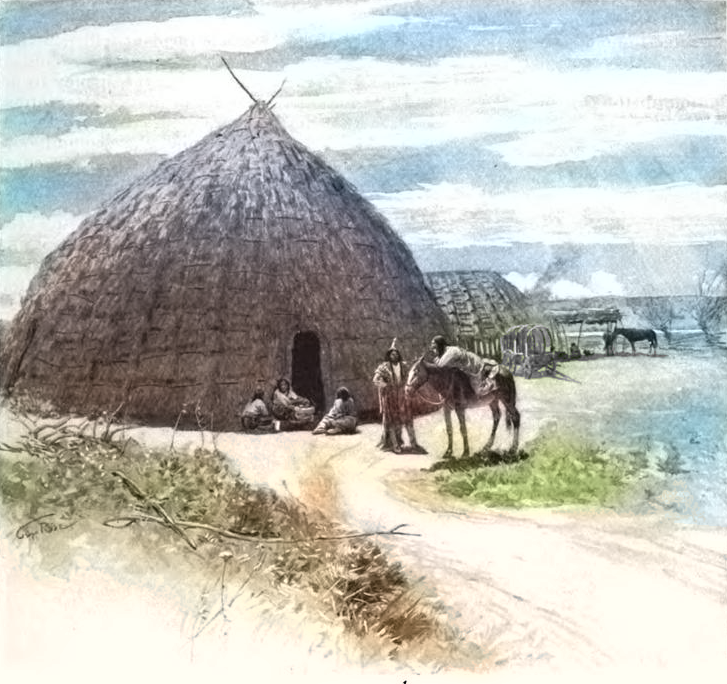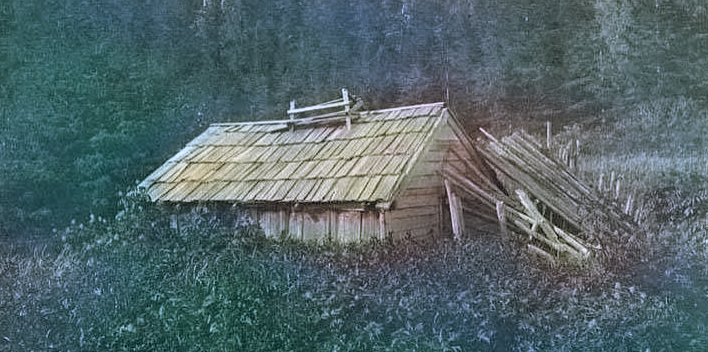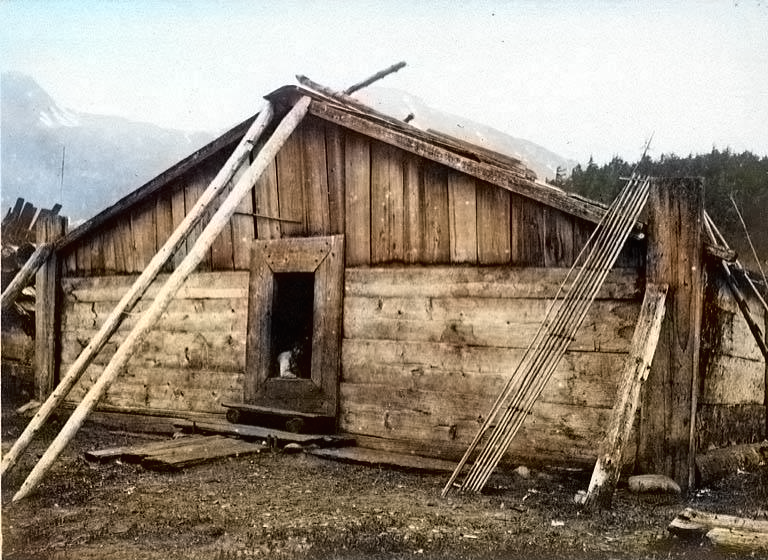Native Americans lived in many different types of housing. Learn about them here!
Introduction
Native Americans lived in many different types of housing. Some tribes were nomadic (they moved around) while others settled down in one place. Also, housing for a warm climate would be very different than for cold temperatures.
Tipis

Tipis of the Shoshoni Tribe, between 1880 and 1910
(From a photo in the Library of Congress, photographer unknown)
Most of the Great Plains Indians were nomadic, so it was important that they could carry around their belongings with ease. This was why tipis (also spelled tepees or teepees) were so crucial to their lifestyle.
To build a tipi, first many wooden poles were criss-crossed in the air to create a cone-shaped structure. Once the poles were safely supported in the ground, a stretched canvas, usually made of buffalo hide, was draped and secured around the poles. A hole was left in the top so that a fire could be built within and smoke could billow out into the air. Mats on the floor inside were often made of buffalo hide, just like the tipi canvas itself.

Tipis of the Flathead Tribe, 1907
(From a photo by Edw Boos)
Building a tipi was a complicated process, but in expert hands one could be set up or broken down in less than an hour. Usually women would do this, as they were largely in charge of domestic affairs. Tipis allowed ease of movement, since households could be rapidly taken down for transport and then set up again. A tipi could be small and hold just a few people, or could be vast enough for a dozen to sleep in!
Grass Houses and Wattle-and-Daub Houses
Grass houses and wattle-and-daub houses were fairly similar.

Grass house on the Wichita Reservation, in what is now Oklahoma
(From a photo by James Mooney, Harper’s New Monthly Magazine, June 1899)
Grass houses were made by Native Americans in the southern part of the Great Plains. These were very tall cone-shaped dwellings made out of thatched (woven) prairie grass covering a frame of wooden sticks.
Wattle-and-daub houses were made of woven sticks, bark, vines, and other plant material (wattle) covered with clay or some other plaster (daub). This type of construction is found all over the world, and it was frequently used by Native Americans in the southeast.
Grass and other plants can be sturdier than one might think when expertly braided and pieced together. But they didn’t stay very warm in cold weather. That’s why grass and wattle-and-daub dwellings are typically found in southern regions, which have warmer temperatures.
Igloos and Pueblos
Igloos and pueblos (or adobe houses) were two types of settlements built in extremely different climates.

Putting the Finishing Touches on an Igloo
(From: Science: An Illustrated Journal, 1883)
Igloos (also known as iglus) were homes made of padded snow and ice blocks — readily available materials in cold northern regions, such as Alaska, northern Canada, and Greenland. Igloos were remarkably good at keeping heat inside, even when the temperature outside was well below freezing! Built by Eskimos (or Inuits), these were an ingenious way to survive a very cold, snowy conditions. They cleverly used the snow to their advantage, packing it up into blocks which were great insulators against the harsh wind. Even body heat would warm up the room, as heat was trapped inside!
A tunnel leading to the outside was buried at least partially in the ground, allowing more warmth to stay in the room (there were only small ventilation holes and windows).
Generally, smaller igloos were more temporary housing, while larger ones that could hold multiple families would last for far longer. An interesting tidbit is that igloo is actually the Eskimos’ term for house, so it can be used for more than just habitation made of snow. It’s uncertain how old the word is, but igloos have been made since at least the 1500s.

Zuni Pueblo, 1873
(From a photo by Timothy H. O’Sullivan)
In contrast, pueblos were built in the very warm southwest. They are also known as adobe houses — adobe is a material made out of mud and grasses, suitable for warm, dry climates. The Pueblo and Hopi tribes dried adobe (or just clay) into bricks in the harsh sun to create these tall, rectangular dwellings. A new layer of clay was applied annually to keep the house in good shape. Pueblos were usually several stories tall–so tall that ladders could be needed to get to the upper rooms!
A pueblo could house many families, and the brick and stone structure helped them last for many years. Of course, it was nearly impossible for these tribes to migrate. In fact, pueblos were often built with one wall being the side of a cliff.
This type of housing is incredibly old. Native Americans have been using cliffs and clay blocks to create houses since 1150!
Wigwams

Cree wigwam, in eastern Canada
(From Notes on the Eastern Cree and Northern Saulteaux, by Alanson Skinner, American Museum of Natural History, 1911)
Another type of dwelling was the wigwam, also known as a birchbark lodge or a wetu. Made in places with many trees, wigwams were built from branches and wooden lumber, with walls made of stretched tree bark or wood. Wigwams were one-room houses which, in contrast to portable tipis, provided more protection from the elements but couldn’t be easily moved. They were sturdy enough that they could last up to a year. Some wigwams were shaped like cones, while others had domed roofs. The Algonquian tribes built entire villages of wigwams, since they farmed and needed to stay in one place.
Longhouses

Seneca-Iroquois longhouse in New York state.
Picture from the US Dept. of the Interior, 1891.
This longhouse has a gable (triangular) roof. Some longhouses had a rounded roof instead.
Longhouses were used by the Iroquois tribes and others in the northeast. They were big, fairly permanent, and kept out much of the rain and wind. While tipis could hold a small family and wigwams a larger one, longhouses could house dozens of people. In fact, a longhouse could be hundreds of feet long (though they were only about 20 feet wide)! They were somewhat similar to log cabins, at least in their wooden permanence.

Front of Iroquois longhouse, northeastern US.
(From a picture in Handbook of American Indians North of Mexico, Smithsonian Institution, Bureau of American Ethnology, 1907.)
Longhouses were constructed with vast wooden planks which were bound together with curved, framing wooden poles. The main part of the house was a big rectangle, with a curved roof above the second floor. All of this together allowed for the longhouses to last for years. This contributed toward a sound village, but meant that the tribe was unable to pick up and move.
Plank Houses

Tlingit plank house, Indian Island, near Juneau, Alaska, 1898
(From a photo by John Francis Pratt)
Plank houses were very permanent wooden structures. Built by Native Americans along the west coast (particularly in the Pacific Northwest), planks were crafted together to make these houses that could withstand rain and cooler temperatures. Because of how hard they are to build, the only tribes that did so were those who wanted to settle down in a particular spot.

Chilkat cedar plank house, 1894 (Chief’s house in Chilkoot Village, Alaska)
(From a photo by John Francis Pratt)
More on Native Americans
Totem poles are huge wooden columns which were made by Native Americans along the Pacific coast of North America. Traditionally, each totem pole tells the story of a Native American family’s ancestral spirits and family history, pictured in human and animal form.
Native Americans lived in many different types of housing. Read about tipis, grass houses, wattle-and-daub houses, pueblos, wigwams, longhouses, plank houses, and even igloos!
A printable worksheet on Pocahontas (1595?-1617), with a short biography, a picture to color, and questions to answer.
Answers: 1. Chief Powhatan, 2. John Smith, 3. Jamestown, 4. John Rolfe, 5. England.
Chief Pontiac (1720-1769) was a great leader of the Ottawa Indian tribe. He organized his and other tribes in the Great Lakes area to fight the British, in what is known as Pontiac’s War.
Sacajawea or Sacagawea (1788-1812) was a Shoshone Indian giude, interpreter, and negotiator for Lewis and Clark on their exploratory expedition to the U.S. West. She traveled with them from North Dakota to the Oregon coast and back.
Read about Sitting Bull (1831-1890), the courageous Lakota leader. He was the last Native American chief to surrender to the U.S. government.
Fill in the blanks in this printout, which is a short biography of the Native American leader Sitting Bull. He was the last chief to surrender to the U.S. government.
Word bank: battle, Canada, expansion, father, South Dakota, Stand, courageously, government, surrender, Custer, reservations, warrior.
Read about Crazy Horse or Tashunka Witko (1849?-1877), a Lakota Sioux warrior who was a leader in the Native American victory over the U.S. government in the Battle of the Little Bighorn, Custer’s Last Stand.
Fill in the blanks in this short biography of the Native American warrior Crazy Horse, who was victorious over Gen. Custer in the Battle of the Little Bighorn.
Word bank: American, army, Bighorn, born, brave, Custer, photographs, reservations, sculpture, South Dakota, surrender, westward.
These printable graphic organizer worksheets can be used to organize material for reports on Native Americans. Includes each of: Canada/Alaska, the U.S., North America, Central America, and South America. Each region has a simple graphic organizer and a more complex graphic organizer.
Find words relating to Native Americans in this wordsearch puzzle. Look up, down, left, right, and diagonally! The PDF file includes both the word-search puzzle and the answer key.
Word bank: Sitting Bull, Powhatan, Sacajawea, Red Cloud, Crazy Horse, Ottawa, Lakota, Ghost Dance, Pontiac, Tribes, Sioux, Pocahontas, Chief, Little Bighorn
Make a tepee, a totem pole, a Kachina doll, a rattle, a dream catcher, and a paper canoe! Or combine a number of these simple crafts on a Native American bulletin board for a visually exciting display.






